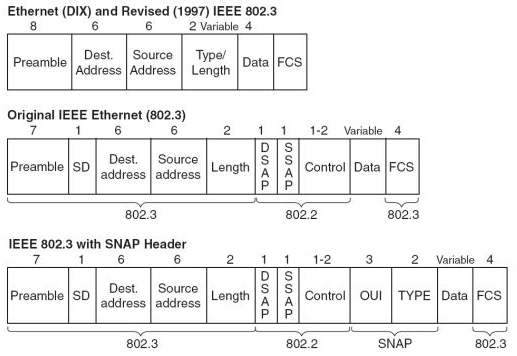• The Ethernet Version 2 or Ethernet II frame, the so-called DIX frame (named after DEC, Intel, and Xerox); this is the most common today, as it is often used directly by the Internet Protocol
• IEEE 802.2 LLC/SNAP frame
• Novell's non-standard variation of IEEE 802.3 ("raw 802.3 frame") without an IEEE 802.2 LLC header.
• IEEE 802.2 LLC frame
Ethernet frames may optionally contain a IEEE 802.1Q tag to identify what VLAN it belongs to and its IEEE 802.1p priority (quality of service). This encapsulation is defined in the IEEE 802.3ac specification and increases the maximum frame by 4 bytes to 1522 bytes. The different frame types have different formats and MTU (maximum transmission unit) values, but can coexist on the same physical medium.
Today we will describe the Ethernet Version 2 (Ethernet II Frame) or the so-called "DIX frame" and the IEEE 802.2 LLC/SNAP frame
Ethernet Version 2 (Ethernet II Frame) or the so-called "DIX frame"
Versions 1.0 and 2.0 of the DIX Ethernet specification have a 16-bit sub-protocol label field called the EtherType. The original IEEE 802.3 Ethernet specification replaced that with a 16-bit length field, with the MAC header followed by an IEEE 802.2 logical link control (LLC) header; the maximum length of a packet was 1500 bytes. The two formats were eventually unified by the convention that values of that field between 0 and 1500 indicated the use of the original 802.3 Ethernet format with a length field, while values of 1536 decimal (0600 hexadecimal) and greater indicated the use of the DIX frame format with an EtherType sub-protocol identifier. This convention allows software to determine whether a frame is an Ethernet II frame or an IEEE 802.3 frame, allowing the coexistence of both standards on the same physical medium.
 Source: http://internetworkexpert.s3.amazonaws.com/2007/11/ethernet-headers.png
Source: http://internetworkexpert.s3.amazonaws.com/2007/11/ethernet-headers.png
IEEE 802.2 LLC/SNAP frame
By examining the 802.2 LLC header, it is possible to determine whether it is followed by a SNAP (subnetwork access protocol) header. Some protocols, particularly those designed for the OSI networking stack, operate directly on top of 802.2 LLC, which provides both datagram and connection-oriented network services. The LLC header includes two additional eight-bit address fields, called service access points or SAPs in OSI terminology; when both source (SSAP) and destination SAP (DSAP) are set to the value 0xAA, the SNAP service is requested. The SNAP header allows EtherType values to be used with all IEEE 802 protocols, as well as supporting private protocol ID spaces. In IEEE 802.3x-1997, the IEEE Ethernet standard was changed to explicitly allow the use of the 16-bit field after the MAC addresses to be used as a length field or a type field.
*Note: Mac OS uses 802.2/SNAP framing for the AppleTalk V2 protocol suite on Ethernet ("EtherTalk") and Ethernet II framing for TCP/IP.



No comments:
Post a Comment